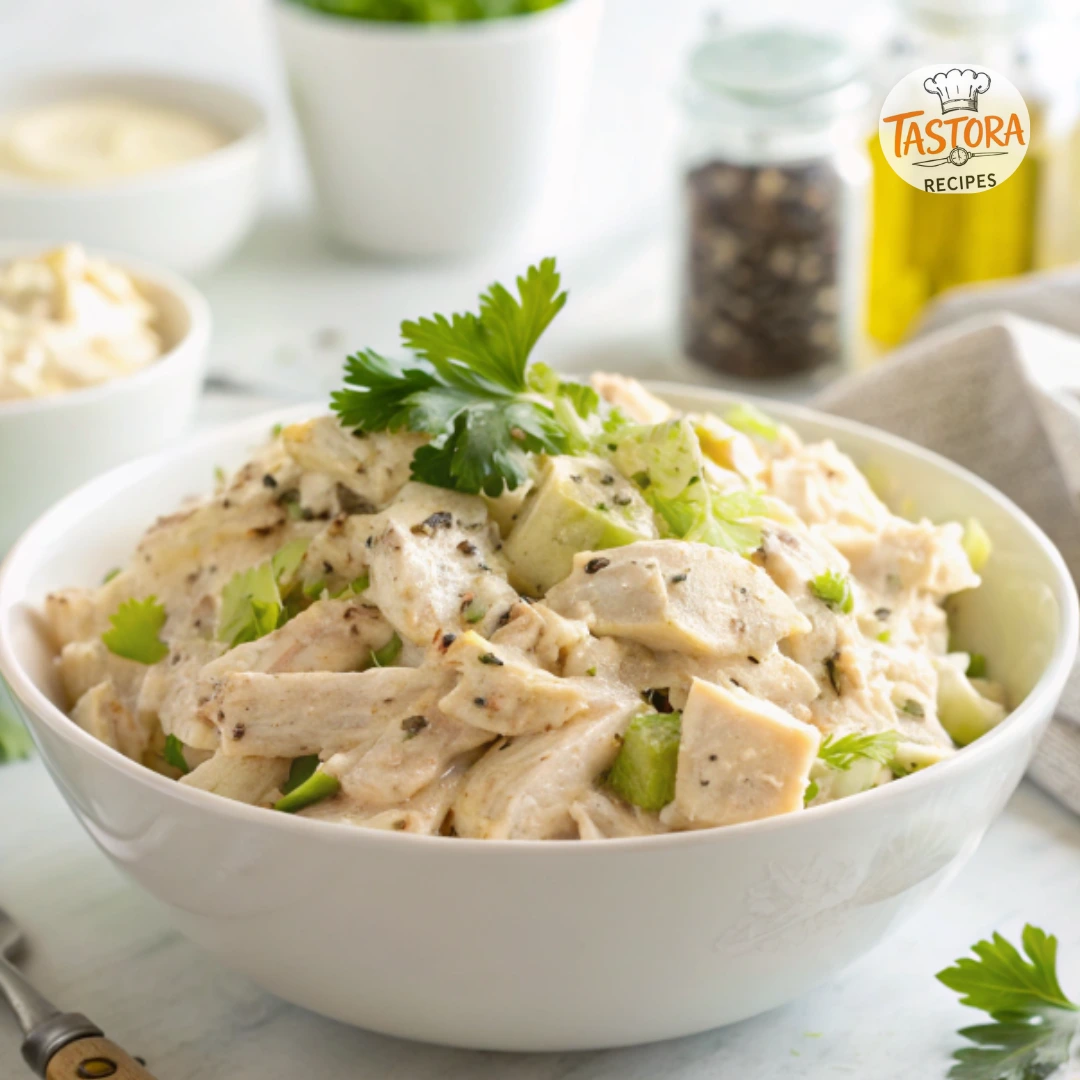Costco Chicken Salad Nutrition: Everything You Need to Know
ingredients and the method of preparation
Costco’s chicken salad has earned its place as one of the warehouse giant’s most beloved deli offerings, flying off the shelves of their famous food court and ready-made sections nationwide. This creamy, protein-packed convenience food has become a staple for busy families, meal preppers, and anyone looking for a quick lunch option with a homestyle flavor. But behind its irresistible taste lies an important question for health-conscious shoppers: what exactly are you getting in terms of nutrition when you scoop up that container of Costco chicken salad? Whether you’re counting calories, tracking macros, or simply trying to make better food choices, understanding the nutritional profile of this popular deli item can help you decide if it belongs in your shopping cart. In this comprehensive guide, we’ll dive into everything from calorie counts and ingredient lists to how it stacks up against competitors and ways to enjoy this convenience food as part of a balanced diet.
Costco Chicken Salad Nutrition Facts
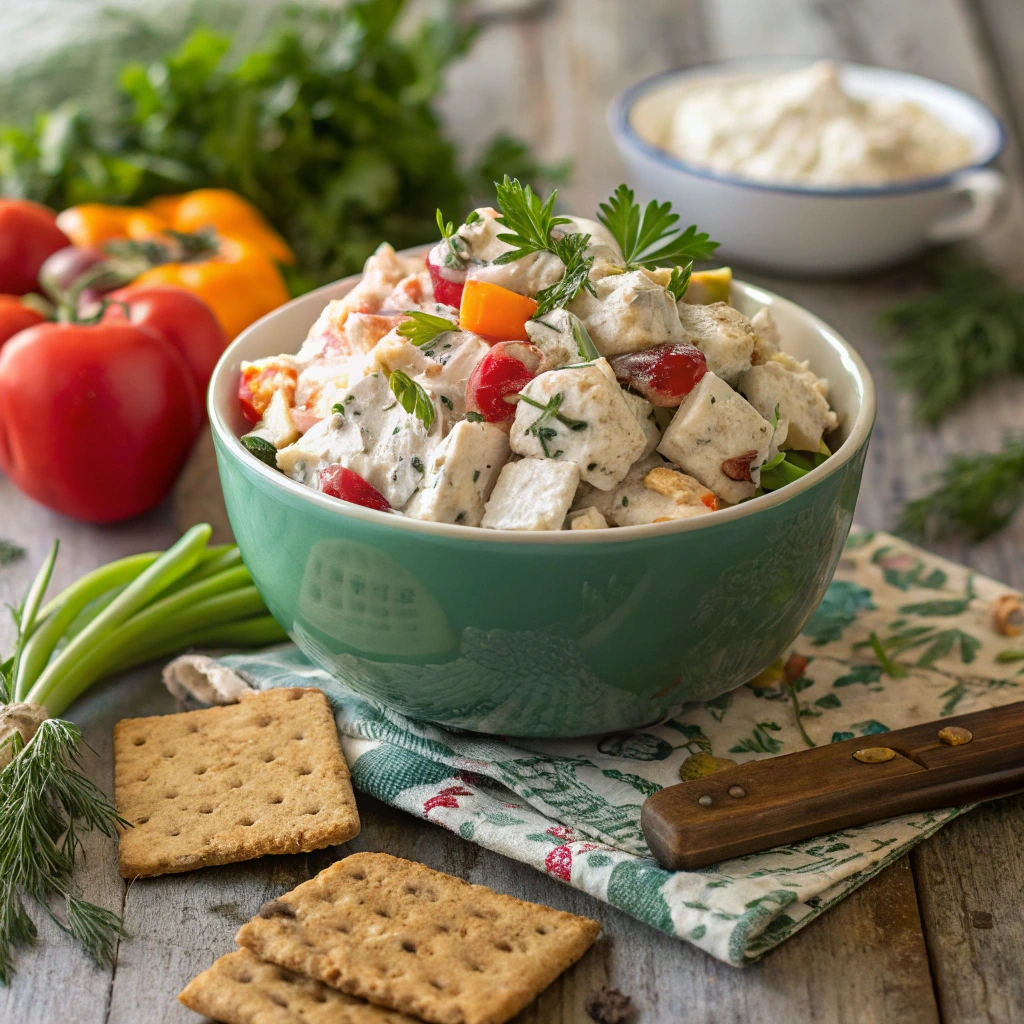
Calories per serving and portion size
Understanding the calorie content of Costco’s chicken salad starts with recognizing their generous portion sizes. A standard serving of Costco chicken salad weighs approximately 3.5 ounces (100 grams), but their containers typically hold much more—often 16 to 32 ounces total. This means a single container can provide multiple servings.
Each 3.5-ounce serving contains approximately 270-290 calories, making it a moderately caloric option that can easily fit into most balanced meal plans. However, portion control becomes crucial, as many consumers underestimate how much they’re actually eating. The plastic containers sold in Costco’s deli section can make it tempting to consume significantly more than one serving in a sitting, potentially turning a reasonable 290-calorie lunch option into a much higher-calorie meal.
For context, when used as a sandwich filling (typically about 4-5 ounces), Costco chicken salad contributes roughly 350-400 calories to your meal before accounting for bread and any additional toppings. When served on a bed of greens or with crackers as part of a lighter lunch, monitoring your portion size becomes even more important for staying within your desired calorie range.
Macronutrients: protein, fat, and carbohydrates
Costco’s chicken salad offers an interesting macronutrient distribution that explains both its satisfying taste and its filling nature. Per 3.5-ounce serving, the breakdown typically includes:
- Protein: 15-18 grams, primarily from the white meat chicken that forms the base of the salad. This substantial protein content makes it a satisfying option that can help maintain muscle mass and provide longer-lasting fullness compared to carb-heavy alternatives.
- Fat: 18-22 grams, with approximately 3-4 grams being saturated fat. The majority of this fat comes from the mayonnaise base, which provides the creamy texture and rich mouthfeel. While the fat content may seem high, it’s worth noting that fat is an essential macronutrient and helps with the absorption of certain vitamins.
- Carbohydrates: 6-9 grams, with 1-2 grams of dietary fiber and 2-3 grams of natural sugars. The relatively low carbohydrate content makes Costco chicken salad an attractive option for those following lower-carb dietary patterns. Most of these carbohydrates come from the vegetables like celery and onions mixed into the salad, as well as small amounts of added sweeteners in the dressing components.
This macronutrient profile—high in protein and fat with minimal carbohydrates—explains why many people find Costco chicken salad to be surprisingly filling despite its creamy texture. It provides steady energy without the quick rise and fall in blood sugar that can come from more carbohydrate-heavy meals.
Key vitamins and minerals in Costco chicken salad
While Costco chicken salad isn’t typically considered a nutritional powerhouse, it does offer several important vitamins and minerals that contribute to its overall nutritional value:
- B vitamins: The chicken component provides significant amounts of B vitamins, particularly niacin (B3), which supports energy metabolism, and B6, which is important for brain development and function. A single serving can provide approximately 20-25% of your daily niacin needs.
- Selenium: Chicken is an excellent source of selenium, an antioxidant mineral that supports immune function and thyroid health. One serving of Costco chicken salad delivers about 15-20% of your daily selenium requirements.
- Phosphorus: Essential for bone health and cellular function, phosphorus is abundant in chicken. A serving of the salad provides roughly 15% of your daily needs.
- Potassium: The combination of chicken and vegetables contributes modest amounts of potassium, which helps regulate fluid balance and muscle contractions. One serving contains approximately 5-8% of your daily potassium requirements.
- Vitamin E: Present in small amounts due to the mayonnaise content, vitamin E functions as an antioxidant in the body, protecting cells from damage.
The vegetable components, though relatively minor in the overall composition, add small amounts of vitamins A and C, while the mayonnaise base contributes some vitamin K. While these micronutrient contributions aren’t substantial enough to rely on Costco chicken salad as a primary source of vitamins and minerals, they do add to its overall nutritional profile and can complement a varied diet.
Costco Chicken Salad Ingredients Breakdown
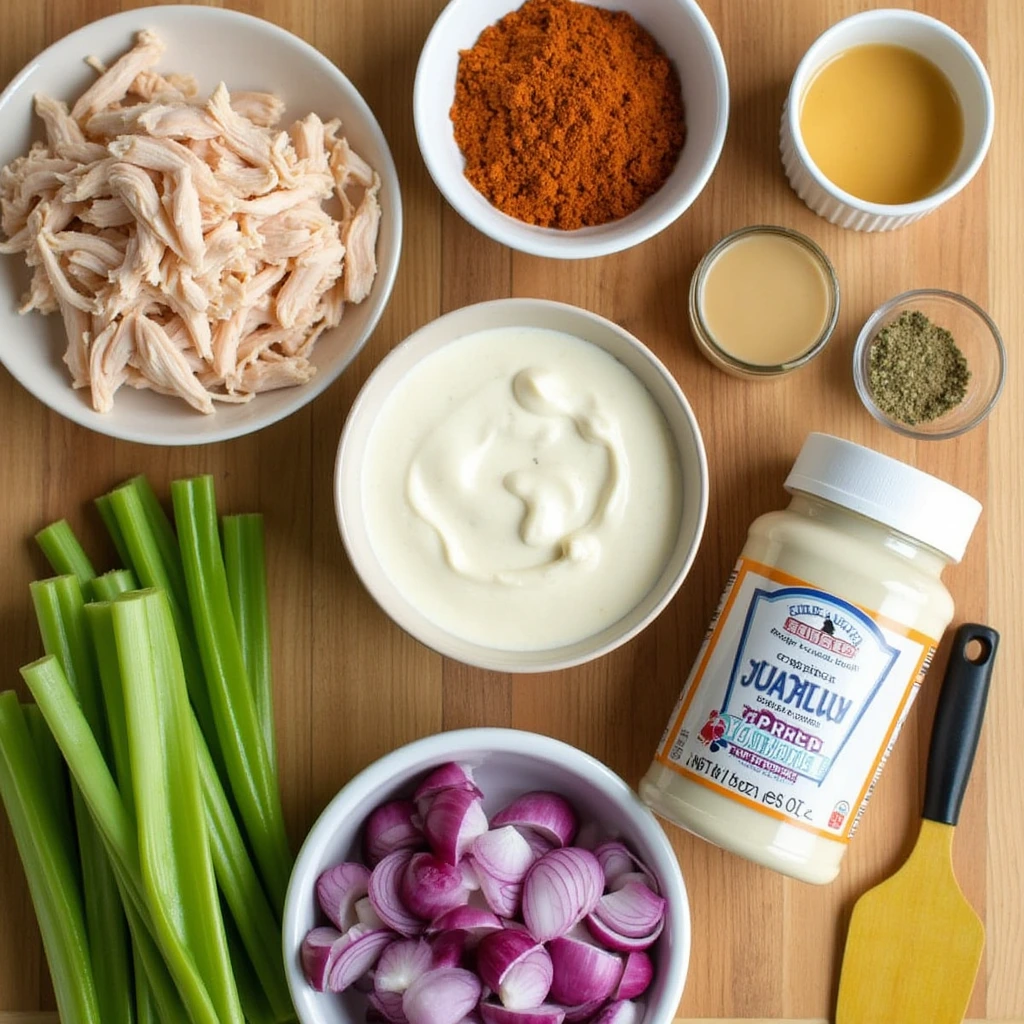
Main ingredients like chicken breast, mayonnaise, and celery
Costco’s chicken salad begins with a foundation of quality ingredients that create its characteristic flavor and texture:
- Chicken Breast: The star ingredient is diced white meat chicken breast, which provides a lean protein base. Costco typically uses roasted chicken that’s been cooled and cut into bite-sized chunks. The chicken is usually lightly seasoned before being incorporated into the salad, giving it a subtle savory quality that serves as the foundation for the other flavors.
- Mayonnaise: The creamy binding agent that gives Costco chicken salad its rich texture is a generous amount of mayonnaise. This emulsion of oil, egg yolks, and acid (typically vinegar or lemon juice) provides both the characteristic mouthfeel and much of the fat content in the final product. Costco typically uses a commercial-grade mayonnaise that’s been formulated for stability and consistent texture in prepared foods.
- Celery: Finely diced celery adds a crucial textural counterpoint to the creamy chicken mixture. Beyond providing a refreshing crunch, celery contributes a subtle vegetal flavor that helps balance the richness of the mayonnaise. The water content in celery also helps maintain moisture in the salad.
- Onions: Mild white or yellow onions are finely minced and added in modest amounts to provide aromatic depth without overwhelming the other flavors. The slight pungency of onions creates complexity in what might otherwise be a one-dimensional creamy dish.
- Seasonings: Salt and black pepper form the basic seasoning profile, with some variations including small amounts of garlic powder or dried herbs to enhance the overall flavor. The seasoning is generally kept subtle to allow the chicken flavor to remain prominent.
These core ingredients create the characteristic flavor profile that has made Costco’s chicken salad a consistent customer favorite across their locations nationwide.
Preservatives or additives used in Costco’s recipe
While Costco’s deli chicken salad aims to deliver a homestyle taste, its commercial preparation and need for shelf stability necessitate the inclusion of certain preservatives and additives:
- Sorbic Acid and Potassium Sorbate: These common preservatives help prevent the growth of mold and yeast, extending the shelf life of the prepared salad. Given the high moisture content and perishable ingredients, these preservatives play an important role in food safety.
- Calcium Disodium EDTA: This additive acts as a chelating agent, binding to metal ions that could otherwise accelerate spoilage, particularly in the mayonnaise component. It helps maintain the consistency and flavor over the product’s shelf life.
- Modified Food Starch: Used in small amounts to help stabilize the creamy texture and prevent separation, this ingredient helps maintain the characteristic consistency of the chicken salad, especially during refrigeration and display.
- Natural Flavors: This broadly defined category typically includes concentrated flavor extracts derived from natural sources. In Costco’s chicken salad, these may enhance the savory notes or round out the flavor profile.
- Citric Acid: While naturally occurring in citrus fruits, commercial citric acid is added as both a flavoring agent to provide a subtle tanginess and as a preservative to help control the growth of bacteria by creating a slightly more acidic environment.
- Xanthan Gum: This thickening agent helps maintain the creamy consistency of the dressing, preventing separation and ensuring a uniform texture throughout the product’s shelf life.
It’s worth noting that while these additives may sound unfamiliar, they’re commonly used in commercial food preparation and are generally recognized as safe by regulatory authorities. However, for consumers seeking a completely additive-free option, these ingredients represent one of the key differences between store-bought and homemade versions.
Comparison to homemade chicken salad ingredients
The differences between Costco’s mass-produced chicken salad and a typical homemade version highlight the trade-offs between convenience and complete ingredient control:
- Chicken Quality and Preparation: Homemade chicken salad typically features freshly cooked chicken—often poached, roasted, or even rotisserie chicken leftovers—where the cook can control the seasoning, cooking method, and quality. Costco uses pre-cooked chicken that’s been processed for consistent flavor and texture, but may lack the distinct roasted or freshly prepared qualities of home-cooked chicken.
- Mayonnaise Base: Many home cooks opt for specific brands of mayonnaise based on personal preference or even make their own using eggs, oil, and acid. This allows for control over oil quality (perhaps using olive oil or avocado oil) and avoiding additives. Costco’s version uses commercial-grade mayonnaise formulated for stability and consistency.
- Vegetable Freshness and Variety: Homemade versions often incorporate a wider variety of fresh vegetables like red bell peppers, fresh herbs, or green onions. The vegetables in homemade chicken salad are typically cut just before mixing, preserving maximum crunchiness and flavor. Costco’s version limits vegetables to those that maintain texture well during storage.
- Customized Additions: Home recipes frequently include personalized touches like halved grapes, diced apples, chopped nuts, or dried cranberries that add textural interest and flavor complexity. These elements are generally absent from Costco’s more standardized recipe, which aims for broad appeal.
- Seasonings and Herbs: Homemade versions can be customized with fresh herbs like dill or tarragon, or specialized seasonings like curry powder or smoked paprika. Costco’s version maintains a more neutral flavor profile designed to appeal to the widest possible customer base.
- Absence of Preservatives: Perhaps the most significant difference is that homemade chicken salad contains no commercial preservatives or stabilizers, as it’s typically prepared for immediate consumption or short-term refrigeration rather than extended shelf life.
The homemade advantage lies in customization and freshness, while Costco’s version offers convenience, consistency, and longer refrigerator life. Many consumers find that while homemade provides superior flavor and ingredient control, the time savings and reliability of Costco’s product make it a worthwhile option for busy weeks or larger gatherings.
Is Costco Chicken Salad Healthy?
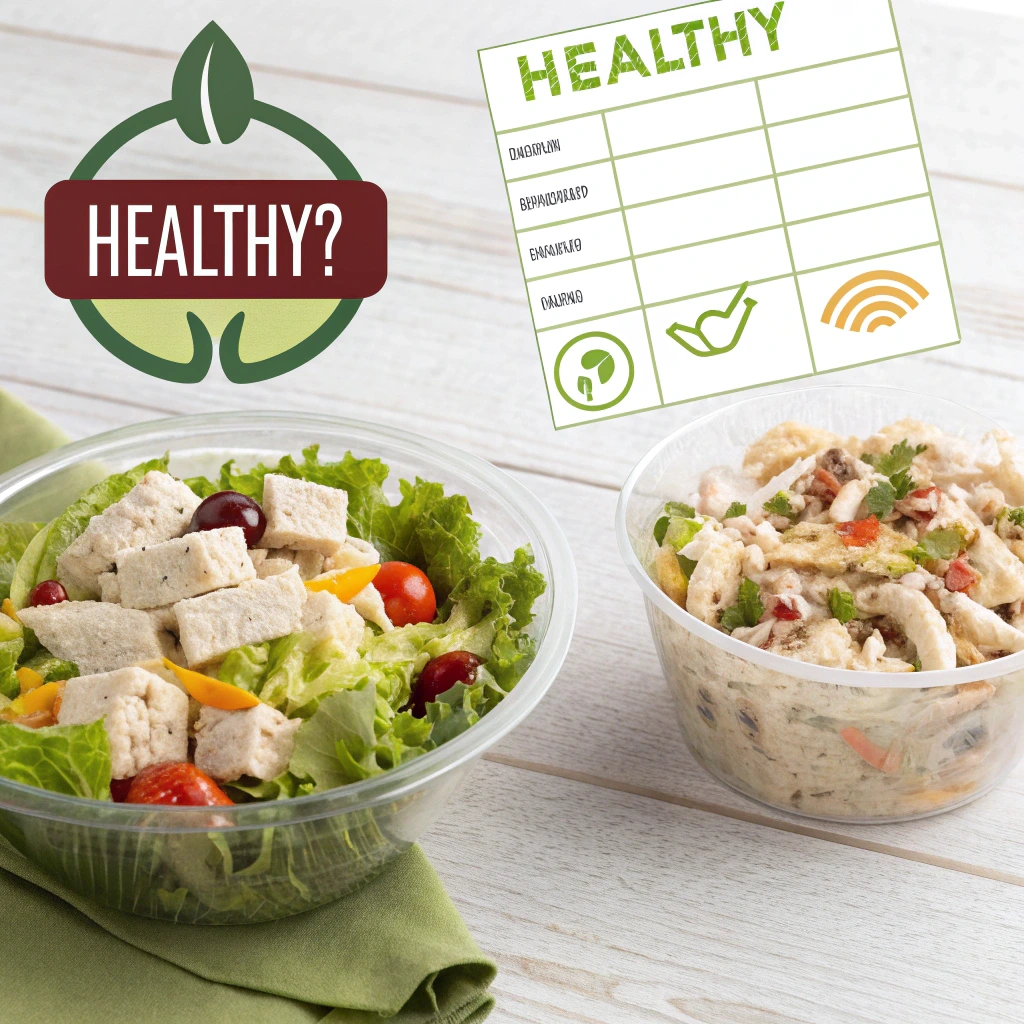
Analysis of fat and calorie content
When evaluating the healthfulness of Costco’s chicken salad, its fat and calorie content deserve particular attention:
The calorie density—approximately 270-290 calories per 3.5-ounce serving—places it in a moderate range for prepared foods. However, the distribution of these calories reveals important nutritional considerations. With 18-22 grams of fat per serving, roughly 60-65% of the total calories come from fat, making it a relatively high-fat food option.
The majority of this fat comes from the mayonnaise base, which is primarily composed of vegetable oils. While these aren’t the unhealthy trans fats that have been largely eliminated from commercial food preparation, they do represent a significant source of omega-6 fatty acids. Nutritional research suggests that modern diets often contain an imbalance of omega-6 to omega-3 fatty acids, potentially contributing to inflammatory conditions.
The saturated fat content—approximately 3-4 grams per serving—falls below the American Heart Association’s recommended daily limit of 13 grams (based on a 2,000 calorie diet), making it reasonable in moderation. However, consuming multiple servings or pairing the chicken salad with other high-fat foods could quickly exceed these recommendations.
From a caloric perspective, portion control becomes the determining factor in whether Costco chicken salad fits into a healthy eating pattern. When consumed in appropriate portions as part of a balanced meal—for example, a scoop of chicken salad on a bed of mixed greens with additional vegetables—it can be incorporated into a nutritious diet. The challenge for many consumers lies in accurately gauging serving sizes, especially when eating directly from the container or using the chicken salad as a sandwich filling, where portions tend to be significantly larger than the standard 3.5-ounce serving.
Whether it fits into diets like keto, low-carb, or high-protein
Costco’s chicken salad aligns surprisingly well with several popular dietary approaches, though with some important caveats:
Ketogenic Diet Compatibility: With only 6-9 grams of carbohydrates per serving and a high fat content, Costco chicken salad fits comfortably within ketogenic dietary guidelines, which typically restrict carbohydrates to 20-50 grams daily while emphasizing fat consumption. The moderate protein content also aligns with keto macronutrient ratios. For strict keto adherents, the only concern might be trace carbohydrates from additives or flavor enhancers, but these are generally minimal.
Low-Carb Diet Suitability: Beyond strict keto, Costco chicken salad works exceptionally well for more moderate low-carb approaches like Atkins or general carbohydrate restriction. When served on cucumber slices, lettuce wraps, or with low-carb crackers instead of bread, it creates a satisfying meal that maintains blood sugar stability. The combination of protein and fat helps promote satiety despite the carbohydrate restriction.
High-Protein Diet Considerations: With 15-18 grams of protein per 3.5-ounce serving, Costco chicken salad contributes meaningfully toward daily protein goals. However, those following high-protein diets for athletic performance or muscle building may find the protein-to-calorie ratio less optimal than leaner protein sources. The substantial fat content means you’re getting relatively fewer protein grams per calorie compared to options like plain chicken breast or Greek yogurt. That said, it still outperforms many convenient lunch options in protein content.
Mediterranean Diet Limitations: Where Costco chicken salad falls short is in alignment with plant-forward eating patterns like the Mediterranean diet. Its heavy reliance on mayonnaise rather than olive oil and limited vegetable content places it outside the ideal Mediterranean pattern, though it could be modified by adding olives, roasted red peppers, and serving it with plenty of fresh vegetables.
DASH and Heart-Healthy Approaches: The sodium content and saturated fat levels make Costco chicken salad less ideal for those following sodium-restricted diets like DASH (Dietary Approaches to Stop Hypertension) or strict heart-healthy eating plans. However, occasional inclusion in moderate portions wouldn’t derail these approaches entirely, especially when balanced with plenty of fresh produce and whole grains throughout the day.
For those tracking macronutrients precisely, Costco chicken salad provides a convenient option with a clear protein/fat/carb distribution that can be factored into daily totals, making it particularly valuable for those following flexible dieting approaches that focus on overall macronutrient targets rather than specific food restrictions.
Healthier alternatives or modifications
For those who enjoy Costco’s chicken salad but want to improve its nutritional profile, several strategic modifications and alternatives can create a healthier option without sacrificing flavor:
Dilution Method: One of the simplest approaches is to extend a portion of Costco chicken salad with additional ingredients that improve its nutritional density. Mixing in extra diced chicken breast increases the protein-to-fat ratio, while adding generous amounts of diced celery, bell peppers, or water chestnuts introduces more fiber, vitamins, and crunch without significantly increasing calories. This effectively dilutes the mayonnaise content per serving while maintaining the familiar flavor profile.
Greek Yogurt Amendment: For a more substantial modification, blend a portion of Costco chicken salad with plain Greek yogurt (approximately 2 parts chicken salad to 1 part yogurt). This reduces the overall fat content while boosting protein and introducing beneficial probiotics. The tanginess of yogurt complements the existing flavor profile, especially when brightened with a squeeze of fresh lemon juice and some freshly ground black pepper.
Serving Modifications: Rather than using chicken salad as the main component of a meal, treat it as a flavorful protein accent in a more vegetable-forward dish
How Costco Chicken Salad Compares to Other Store-Bought Options
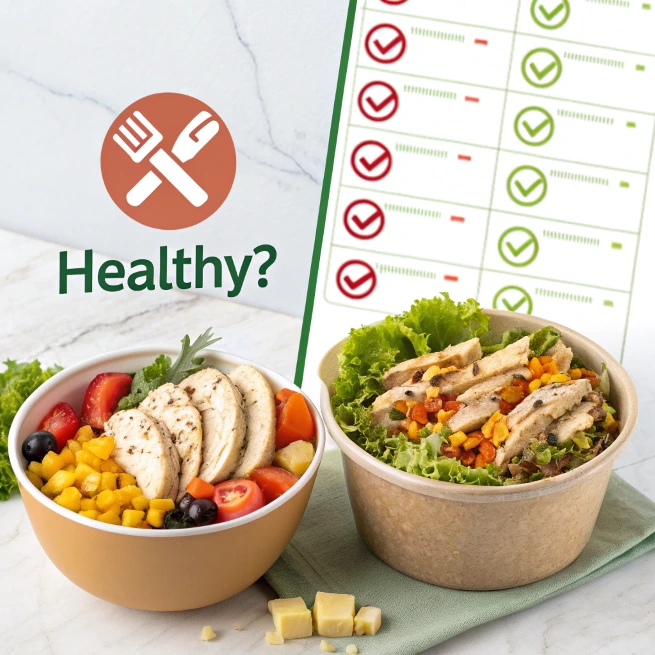
Nutritional comparison with similar deli chicken salads
When comparing Costco’s chicken salad to offerings from other major retailers and delis, several nutritional distinctions become apparent:
Costco’s chicken salad typically contains 270-290 calories per 3.5-ounce serving, placing it in the middle range compared to competitors. Whole Foods’ chicken salad averages slightly higher at 300-320 calories per equivalent serving, largely due to the inclusion of additional ingredients like nuts or dried fruit. Walmart’s deli chicken salad comes in lower at around 230-250 calories, though with notably less chicken content per serving.
Protein content is where Costco’s offering particularly shines. With 15-18 grams of protein per serving, it outperforms the average grocery store deli version (typically 10-14 grams) and matches premium competitors like those from Trader Joe’s. This higher protein content reflects Costco’s more generous use of chicken relative to mayonnaise and fillers.
The fat profile shows interesting variations as well. Costco’s version contains 18-22 grams of total fat per serving, with 3-4 grams being saturated. By comparison, traditional supermarket deli versions often contain 16-20 grams of fat but with higher saturated fat percentages (4-6 grams), suggesting Costco may use oils with better fatty acid profiles in their mayonnaise base.
Sodium content represents perhaps the most significant nutritional difference. Costco’s chicken salad contains approximately 460-500mg of sodium per serving, which is notably lower than many competitors. Deli counter versions from conventional supermarkets frequently reach 600-700mg per equivalent serving, making Costco’s version potentially advantageous for those monitoring sodium intake.
Carbohydrate content remains relatively consistent across brands (6-10 grams per serving), though premium versions like those from Whole Foods or specialty delis often incorporate ingredients like grapes or apples that increase the carbohydrate count while adding nutritional value through additional vitamins and fiber.
These comparative metrics suggest that Costco’s chicken salad offers a competitive nutritional profile within the commercial deli salad category, particularly for consumers prioritizing protein content and moderate sodium levels.
Differences in ingredients and portion sizes
Beyond nutritional numbers, the ingredient quality and portioning strategies vary significantly among store-bought chicken salads:
Costco distinguishes itself through portion size and packaging approach. Their typical container holds 32 ounces (2 pounds) of chicken salad, designed for multiple servings or family consumption. This bulk packaging creates both value and a potential portion control challenge compared to competitors like Trader Joe’s or Whole Foods, which often offer single-serving containers around 5-7 ounces or medium-sized containers of 12-16 ounces.
Ingredient examination reveals meaningful differences in chicken quality and preparation. Costco uses sizeable chunks of roasted white meat chicken, while many supermarket delis utilize smaller, more finely diced chicken pieces that sometimes include dark meat. Premium competitors like Fresh Market or Whole Foods often specify antibiotic-free or organic chicken, though at substantially higher price points.
The mayonnaise base shows considerable variation across retailers. Costco uses a traditional mayonnaise formulation, while some competitors incorporate alternative ingredients to create marketing distinctions. Sprouts Farmers Market offers a version with olive oil mayonnaise, while Trader Joe’s sometimes features a “light” version using reduced-fat mayonnaise. These alternatives affect both nutritional content and flavor profile.
Additional ingredients create the most visible differentiation among competitors. Standard supermarket versions tend toward simplicity with just mayonnaise, chicken, celery, and onion—similar to Costco’s approach. Premium competitors distinguish themselves through additions: Whole Foods often includes almonds or walnuts; Wegmans features variations with grapes or cranberries; Trader Joe’s incorporates herbs like dill or tarragon in some versions.
Preservative use also varies significantly. Costco’s version contains standard commercial preservatives for extended shelf life. Some upscale competitors emphasize shorter shelf life with minimal preservatives as a selling point, while budget versions sometimes contain more extensive preservative systems and flavor enhancers to maintain palatability despite lower-quality base ingredients.
These ingredient and portion differences reflect each retailer’s positioning strategy. Costco emphasizes value and consistency for family consumption, while specialty retailers focus on premium ingredients or distinctive flavor profiles, often at substantially higher price points per ounce.
Taste and texture comparison
The sensory experience of Costco’s chicken salad compared to competitors reveals nuances that numerical nutritional data cannot capture:
Costco’s version features a distinctive texture characterized by substantial chicken chunks that maintain their integrity rather than dissolving into the creamy base. This creates a more substantial mouthfeel compared to many supermarket deli versions, where smaller chicken pieces often become indistinguishable in the mayonnaise mixture. The generous chicken-to-mayonnaise ratio gives Costco’s salad a hearty quality that many consumers prefer, especially when used as a sandwich filling.
The flavor profile of Costco’s chicken salad sits comfortably in the middle of the intensity spectrum. It offers a straightforward, classic taste without strong herb notes or distinctive seasonings. This contrasts with Whole Foods’ versions, which often incorporate more aggressive herbal elements like dill or tarragon, or specialty delis that might include curry powder or smoked paprika variations. Costco’s relatively neutral seasoning makes it adaptable as both a standalone dish and an ingredient in other recipes.
The sweetness level represents another point of differentiation. Costco’s chicken salad contains minimal added sweetness, unlike some competitors that incorporate sweet pickle relish or subtle sweeteners to balance the mayonnaise’s richness. Trader Joe’s versions, for example, often feature a slightly sweeter profile, while traditional deli counter versions frequently include sweet pickle elements that Costco’s does not.
Textural contrast comes primarily from finely diced celery in Costco’s version. This provides a clean, crisp counterpoint to the creamy base without introducing competing flavors. Other retailers often incorporate additional crunchy elements—water chestnuts at premium Asian-influenced delis, diced apples at Whole Foods, or sliced almonds at specialty markets—creating more complex textural experiences but also more polarizing flavor profiles.
Mayonnaise quality significantly impacts the overall impression. Costco’s version features a rich, full-bodied mayonnaise that creates a coating mouthfeel rather than a runny or watery texture sometimes found in budget versions. It successfully balances creaminess without overwhelming the chicken’s flavor, though some consumers who prefer tangier mayo profiles might find it somewhat neutral.
These sensory characteristics make Costco’s chicken salad a reliable, crowd-pleasing option that prioritizes approachability and versatility over distinctive or polarizing flavor elements. For consumers seeking a more distinctive taste experience, specialty deli versions offer greater variation but typically at a higher price point and with less consistent availability.
Tips for Making a Healthier Chicken Salad at Home
Using Greek yogurt instead of mayonnaise
Substituting Greek yogurt for traditional mayonnaise represents one of the most impactful nutritional improvements when making chicken salad at home:
A full cup of mayonnaise contains approximately 1,440 calories and 160 grams of fat, while the same amount of 2% Greek yogurt provides just 240 calories and 10 grams of fat—a reduction of over 80% in both measures. This dramatic difference allows for significant calorie reduction while maintaining the creamy texture essential to chicken salad. Additionally, Greek yogurt contributes approximately 20 grams of protein per cup compared to mayonnaise’s negligible protein content, substantially improving the salad’s protein-to-calorie ratio.
The tangy profile of Greek yogurt creates a flavor challenge that requires thoughtful adaptation. A complete substitution often results in a sharper taste than traditional expectations. The most successful approach combines Greek yogurt with a smaller amount of quality mayonnaise—a ratio of 2:1 or 3:1 yogurt to mayonnaise preserves the familiar flavor foundation while dramatically improving the nutritional profile. This hybrid approach reduces calories by 65-75% compared to an all-mayonnaise version while maintaining a familiar taste.
Texture stabilization becomes important when working with yogurt-based dressings. Greek yogurt’s higher water content can make the salad watery over time, especially when mixed with vegetables that release moisture. Adding a tablespoon of chia seeds or ground flaxseed per cup of dressing helps absorb excess moisture while contributing beneficial omega-3 fatty acids and fiber. Alternatively, straining the yogurt through cheesecloth for 1-2 hours before mixing creates an even thicker base that more closely mimics mayonnaise’s stability.
Flavor enhancement becomes particularly important with yogurt-based dressings. Adding 1-2 teaspoons of Dijon mustard per cup of dressing helps bridge the flavor gap between yogurt and mayonnaise while contributing minimal calories. Fresh herbs like dill, parsley, or tarragon add complexity that distracts from the missing richness of full-fat mayonnaise. A small amount of honey (1-2 teaspoons per cup) helps balance yogurt’s tanginess without significantly impacting the overall calorie reduction.
For those who find the transition to Greek yogurt challenging, a gradual adaptation approach often proves successful. Beginning with a 1:1 ratio of yogurt to mayonnaise and gradually shifting toward more yogurt over several preparations allows taste preferences to adjust incrementally. Many people find that after several exposures, they prefer the lighter, tangier profile of yogurt-based chicken salad, especially when brightened with fresh lemon zest or herbs.
This substitution strategy creates a chicken salad with approximately 140-160 calories per serving compared to the 270-290 found in Costco’s version—a reduction that allows for either larger portions or additional nutritious add-ins while staying within the same calorie framework.
Adding more fresh vegetables for fiber and crunch
Increasing the vegetable content of homemade chicken salad creates multiple nutritional benefits while enhancing textural interest and flavor complexity:
Traditional recipes (including Costco’s version) typically incorporate only celery and sometimes onion, representing a missed opportunity for nutrient density. Adding a diverse array of vegetables increases fiber content—crucial for digestive health and sustained fullness—while contributing essential vitamins and minerals. A chicken salad with 40-50% vegetable content by volume can provide 3-4 grams of fiber per serving compared to the 1-2 grams in conventional versions.
Strategic vegetable selection should balance nutritional benefits with textural contribution and flavor compatibility. Bell peppers (particularly red and orange varieties) add vibrant color, sweet-crisp texture, and substantial vitamin C—a single cup provides over 100% of daily requirements. Diced jicama offers exceptional crunch persistence even after days in the refrigerator while contributing prebiotic fiber that supports gut health. Shredded carrots introduce natural sweetness and beta-carotene without overwhelming the flavor profile.
Water-containing vegetables require special handling to prevent excess moisture from diluting the dressing. Cucumber, while nutritionally valuable for its silica content and refreshing flavor, should be seeded before dicing and can benefit from a light salting and draining process (10 minutes salted in a colander) before incorporation. Similarly, radishes should be patted dry after chopping to maintain dressing consistency.
Leafy additions like finely shredded kale or baby spinach significantly boost nutrient density—particularly vitamin K, folate, and calcium—while adding minimal calories. These should be added in small amounts (finely chopped) to maintain the salad’s cohesive texture rather than creating a true garden salad feel. Massaging hearty greens like kale with a small amount of lemon juice or dressing 10-15 minutes before incorporating helps soften their texture while preserving nutritional value.
Aromatic vegetables like red onion, scallions, or shallots contribute flavor complexity and prebiotics. Using quick-pickle techniques (soaking sliced onions in ice water with a splash of vinegar for 10-15 minutes) reduces their sharpness while preserving their crisp texture and beneficial compounds. This approach makes chicken salad more accessible to those who find raw onions overwhelming.
For maximum nutritional benefit, aim for a rainbow approach—incorporating vegetables of different colors ensures a diverse phytonutrient profile. A practical target is 1 cup of mixed vegetables per 2 cups of chicken salad base, which substantially increases volume and satiety while proportionally reducing calories per serving.
Controlling portion sizes for a balanced meal
Effective portion management transforms chicken salad from a potential caloric pitfall into a nutritious component of a balanced eating pattern:
Understanding appropriate serving sizes provides the foundation for portion control. A nutritionally balanced portion of traditional chicken salad (like Costco’s version) is approximately 1/2 cup or 3.5 ounces—significantly less than many people typically serve themselves. This portion delivers approximately 15-18 grams of protein, making it appropriate as the protein component of a meal rather than the entire meal itself.
Visual calibration techniques help establish proper portions without requiring constant measuring. A serving of chicken salad approximately matches the size of a tennis ball or fills a standard cupcake liner—visual references that can be used when serving from larger containers. For those tracking more precisely, using a food scale for the first few preparations helps develop accurate visual estimation skills for future reference.
The plate composition method effectively balances chicken salad within a complete meal. Start with a base of non-starchy vegetables (leafy greens, cucumber slices, bell pepper strips) covering half the plate, add a portion-controlled scoop of chicken salad (1/2 cup) occupying one quarter, and complete the meal with a small portion of complex carbohydrates (whole grain crackers, quinoa, or sweet potato) in the remaining quarter.
The sandwich strategy requires particular attention to maintain balance. Rather than creating a densely packed sandwich with multiple layers of chicken salad, spread a measured amount (1/3 to 1/2 cup) thinly on a single slice of whole grain bread, then top with substantial layers of vegetables like sliced tomato, cucumber, sprouts, and lettuce before adding the second bread slice. This creates a satisfying sandwich volume with moderate chicken salad content.
Pre-portioning techniques support consistent portion control, especially for busy schedules. Dividing a batch of homemade chicken salad into individual containers matching appropriate serving sizes eliminates the temptation to overserve in the moment. For lunch preparation, combining these pre-portioned containers with separate containers of vegetables and complex carbohydrates allows for quick assembly of balanced meals.
Volumizing strategies can satisfy hunger while maintaining appropriate chicken salad portions. Serving a moderate amount of chicken salad over a substantial bed of greens or alongside raw vegetable crudités provides the visual and physical satisfaction of a large meal while keeping the calorie-dense chicken salad component in proportion.
This thoughtful approach to portioning allows chicken salad to remain a convenient, protein-rich component of a nutritious diet without the caloric excess that can result from unrestricted portions of this relatively energy-dense food.
Ingredients:
- 3 cups cooked rotisserie chicken (shredded or diced)
- ½ cup mayonnaise (or Greek yogurt for a healthier option)
- ¼ cup celery (finely chopped)
- ¼ cup red onion (finely chopped)
- 1 teaspoon Dijon mustard (optional for flavor)
- 1 teaspoon lemon juice (for freshness)
- ½ teaspoon garlic powder
- ½ teaspoon onion powder
- ½ teaspoon salt (adjust to taste)
- ¼ teaspoon black pepper
- 1 teaspoon fresh parsley (chopped, optional)
Method of Preparation:
- Prepare the Chicken:
- Shred or dice the rotisserie chicken into small, bite-sized pieces.
- Mix the Dressing:
- In a large bowl, whisk together the mayonnaise, Dijon mustard, lemon juice, garlic powder, onion powder, salt, and black pepper until smooth.
- Combine Ingredients:
- Add the shredded chicken, celery, red onion, and parsley to the bowl.
- Stir everything until well coated with the dressing.
- Chill and Serve:
- Cover and refrigerate for at least 30 minutes to let the flavors meld.
- Serve chilled on a sandwich, in a wrap, over salad greens, or with crackers.
Conclusion
Costco’s chicken salad represents the perfect intersection of convenience, flavor, and nutrition that today’s health-conscious consumers seek in ready-made options. While it’s not a low-calorie food, its impressive protein content and moderate carbohydrate profile make it a surprisingly versatile option that can fit into various dietary approaches when portioned thoughtfully. The nutritional profile—270-290 calories per serving with 15-18 grams of protein—compares favorably with many other deli offerings, particularly when considering Costco’s competitive pricing and generous chicken content.
Understanding both the strengths (high protein, convenience, value) and limitations (moderate fat content, preservatives) of this popular deli item empowers consumers to make informed choices that align with their personal health goals. For those watching calories or seeking to optimize nutrition, the homemade modifications explored here—particularly the Greek yogurt substitution and increased vegetable content—provide practical pathways to enjoy chicken salad’s satisfying flavor profile with enhanced nutritional benefits.
Whether you’re grabbing a container from Costco’s deli section as an occasional convenience food, using it as inspiration for your own healthier homemade version, or finding a middle ground by doctoring the store-bought option with additional fresh ingredients, chicken salad can be part of a balanced approach to eating. The key lies in portion awareness, thoughtful meal composition, and understanding where this popular dish fits within your overall nutritional needs.
In the landscape of prepared foods, Costco’s chicken salad stands as a testament to the fact that convenience doesn’t have to come at the cost of good nutrition—especially when armed with the knowledge to make it work optimally within your personal health journey.
Are you ready to try this recipe?
There are no reviews yet. Be the first one to write one.

